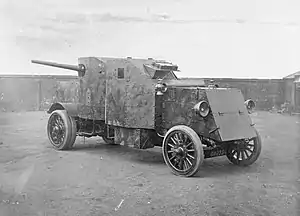| Pierce-Arrow armoured lorry | |
|---|---|
 | |
| Type | Armoured car |
| Place of origin | United Kingdom |
| Service history | |
| In service | 1916–1918 |
| Used by | Royal Naval Air Service |
| Wars | First World War |
| Production history | |
| Manufacturer | W. G. Allen & Sons, Tipton & John Shearman & Co, Newport |
| Produced | 1916 |
| No. built | 2 |
| Specifications | |
| Armour | 5⁄8 in (15.9 mm) |
Main armament | 1 x QF 3-pounder (47 mm) Vickers |
| Engine | 4-cylinder petrol 30 hp (22 kW) |
| Drive | 4x2 |
| Suspension | Leaf springs |
The Pierce-Arrow armoured lorry was a heavy armoured car mounting a QF 3-pounder Vickers gun, it was used by the Royal Naval Air Service during the First World War.
Design
The Pierce-Arrow armoured lorry was a turreted armoured lorry based on an imported American Pierce-Arrow Motor Car Company 5-ton truck chassis with added armoured bodywork, it was armed with a turreted QF 3-pounder Vickers gun.[1][2][3] The Pierce-Arrow had a front mounted engine protected by folding armoured panels, behind the engine was an enclosed driver's compartment a single two armoured shutter, the turret was behind the driver's compartment.[1] The Pierce-Arrow armoured lorry used the same chassis as the Pierce-Arrow armoured AA lorry, it used identical bonnet armour as the latter whilst the driver's compartment was reduced to half width to allow the main gun to fire forwards.[3]
History
Construction of the two Pierce-Arrow armoured lorries was carried out by W. G. Allen & Sons in Tipton, who used 5⁄8 inch (15.9 mm) armoured plate for the fighting compartment, the turret turntables were manufactured by John Shearman & Co at Newport, Wales, where the RNAS had a depot to service armoured cars.[1][2][3] The two vehicles were dispatched to Russia in 1916 with No 1 Squadron, Royal Naval Armoured Car Division under Commander Oliver Locker-Lampson for the expedition to Russia and the Causasus.[1][2][3] Throughout the campaign the Pierce-Arrows provided heavy fire support to the lighter Lanchester armoured cars that made up the bulk of the force.[1][3] In Russia the weight proved to be too heavy for the chassis so the turrets were removed, and the guns were mounted on a pedestal with a shield, and the hull sides were filled in with flat plates.[3]
See also
References
- 1 2 3 4 5 Foss, Christopher F. (2002). The encyclopedia of tanks & armoured fighting vehicles. London: Amber Books. p. 141. ISBN 978-1905704-44-6.
- 1 2 3 "The RNAS armoured car division on the Eastern Front 1915-1918". Imperial War Museum. Retrieved 20 December 2019.
- 1 2 3 4 5 6 White, Brian Terence (1970). British tanks and fighting vehicles, 1914-1945. London: Ian Allan. pp. 111–112. ISBN 0-7110-0123-5.